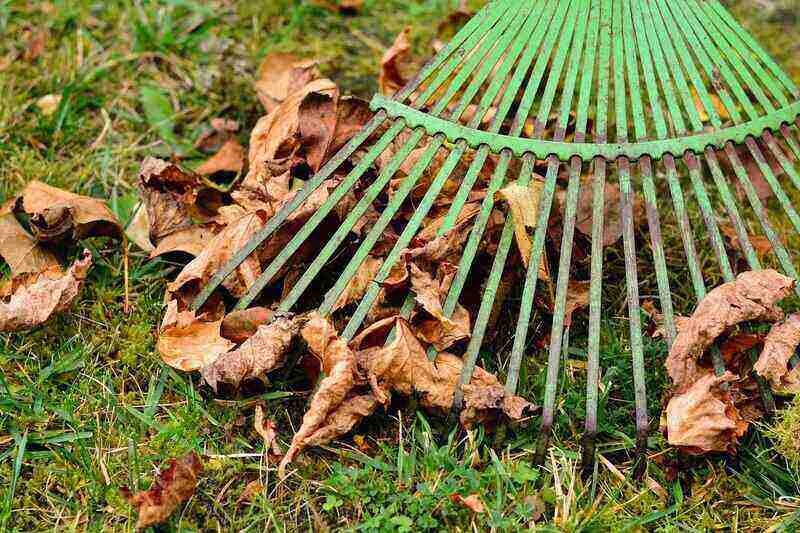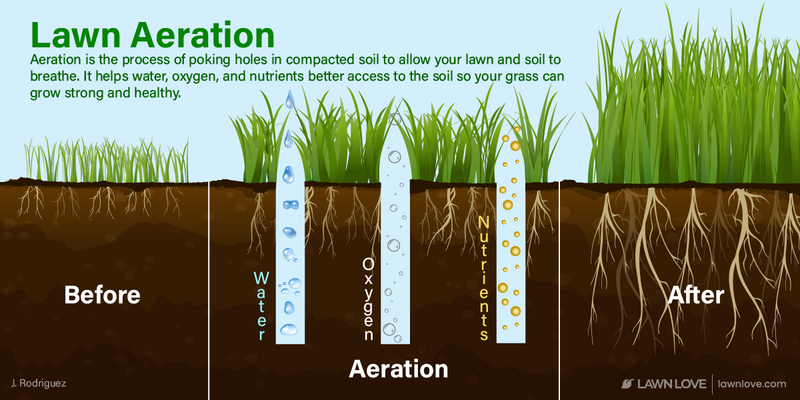
As the gray weather and harsh winter fades in Buffalo, the emerald green starts to slowly peek through the melting snow. You begin to think about picnics, cookouts, and frisbee. But before inviting guests over, your lawn needs a little attention. Not sure where to start? Try these nine spring lawn care tips for your Buffalo lawn.

1. Spring cleanup
Before your crocuses bloom, grab your rake and get your yard shipshape for spring. Pick up sticks, tree branches, and rake up any leftover leaves and gravel on your lawn left by snow plows.
Here’s why: All that debris from last year’s fallen leaves can lead to grass suffocation in spring. You want your grass to grow, not suffocate.
What to do with that lawn debris? Start a compost pile or add to an existing one.
Reasons to compost:
- Enhances the soil
- Retains moisture
- Lessens the possibility of plant diseases and pests
- Use less store-bought fertilizers
- Decreases carbon footprint
Composting at home is one of the best things you can do for your lawn. It makes a great top dressing for heavy soils (aerate first for best results), and best of all — it’s free.

2. Test your soil
Is your ground ready to support your spring flowers and lush lawn? Has the winter taken a toll on the earth under your feet — as well as you?
Test your soil, so you know if you need to apply any fertilizer. (While fertilizer is more efficient if spread in the fall, spring fertilization also might be required.)
You can find a home soil test kit at any nursery or garden center, but you’ll get more detailed results if you test your soil through the Cornell Cooperative Extension Office.
To obtain a soil sample, follow these simple steps:
- Use a garden spade or shovel and remove a sample from the upper 6 inches of your turf
- Perform the same task in about a dozen areas throughout your lawn
- Collect a total of about 2 cups of soil
- Be sure the samples are dry

3. Nourish with fertilizer
The results from your soil test will provide the recipe for the correct mixture of essential nutrients – nitrogen, phosphorus, and potassium. Think of fertilizer as a proper diet for your lawn.
Nitrogen, phosphorus, and potassium are three essential nutrients necessary for growth. These three are referred to as N-P-K. To simplify, if your fertilizer ratio is 20-5-10, then 20% is nitrogen, 5% phosphorus, and 10% potassium.
If you need to apply fertilizer, you have some choices to make, including what type of fertilizer and how will you spread that fertilizer:
- What type of fertilizer do you prefer? Granular or liquid.
- How will you spread your fertilizer? Lawn spreader or lawn sprayer.
A couple of tips to keep in mind as you fertilize your lawn:
- Soil should be moist, which will require you to water about three days before you apply it..
- Cover yourself so you do not come in contact with the chemicals.
- Refrain from walking on the fertilized lawn for about 48 hours.
Beware: Fertilizers can be “ruff” on a dog. If chemicals are a concern, choose a pet-friendly fertilizer alternative instead like:
- Fish emulsion
- Grass clippings
- Manure
- Compost
- Bone meal/blood meal

4. Aerate your lawn
To give your lawn a healthier and stronger root system, aerate your soil. Aeration also allows important nutrients, water, and oxygen to penetrate the soil.
In western New York, the best time to aerate is early spring between March and April. That’s also the peak season for greening up and springtime grass growth.
What is aeration? Aeration creates small holes in the lawn to alleviate compacted soil.
Benefits of aerating:
- Increases nutrient absorption
- Promotes grass growth
- Provides better water drainage
- Breaks up soil
- Discourages compaction
Depending on the size of your yard, aerating can be done manually by poking holes with a spike aerator or with a core aeration machine, which is ideal for large lawns.
However, no matter your lawn size, aerating can be time-consuming, and possibly back breaking. Lawn Love can take the aerating chore off your plate.

5. Kill those weeds
Just the word “weeds” makes you cringe. Like an unpleasant neighbor, weeds invade our space and are most undesirable. Thankfully, getting rid of weeds is an easier fix than getting rid of neighbors.
Here are just a few of the weeds common in lawns from Buffalo to Niagara Falls to Cheektowaga:
Certain weeds can be pulled by hand, but think of this as a last resort.
The most effective and efficient method of getting rid of weeds is to block them from springing up in your yard. How to do this: “Wrestle” those weeds out of your cool-season lawn with a pre-emergent herbicide in early spring.
If weeds have already poked through the grass, a post-emergent herbicide is the remedy. Just spray your weeds away with a weed killer.
When tackling weeds in your yard, take these precautions:
- Wear protective gloves and clothing, including goggles.
- Read the application instructions carefully.
- Do not apply on a windy day.
- Store containers away from children and pets.
While some weeds, such as dandelions, might appear to be pretty little flowers, here are four reasons these lawn interlopers need to be controlled.
Weeds will:
- Monopolize garden space
- Discourage “good” plants from thriving
- Greedily suck up water and other nutrients
- House undesirable insects

6. Check your lawn mower
Before your first mow of spring, make sure you’re current on your lawn mower maintenance. Follow this simple lawn mower maintenance checklist:
- Sharpen or replace the lawn mower blade. Why? Dull blades will hack your grass instead of a nice clean cut.
- Clean all debris or clippings still clinging to the mower from last fall.
- Lubricate the wheels.
- Clean or replace the filter.
- Purchase fresh fuel for the gas mower.
- Fully charge the battery before the first spring mow.
- Check oil and change it, if necessary.

7. Know when to mow
In Cheektowaga, Buffalo, and Niagara Falls, we have cool-season grasses that can tolerate frigid temperatures and moderate summers.
The four most popular cool season grasses are:
- Fine fescue
- Tall fescue
- Kentucky bluegrass
- Perennial ryegrass
Follow these tips to properly mow your cool-season lawn:
- Wait until the outside temperature is consistently 40 degrees before your first mow. (Grass should be fully thawed. Otherwise, you can cause ruts in the lawn and even damage your mower.)
- Mow at least once every four to seven days, depending on the rain and growth conditions.
- Do not cut off more than one-third of the grass blade as it could stress the soil and result in dry patches.
- Use your grass clippings as an organic fertilizer.
Recommended height for cool-season grasses:
- Fine fescue: 1.5-3 inches
- Tall fescue: 2-4 inches
- Kentucky bluegrass: 2-3 inches
- Perennial ryegrass: 2-3 inches

8. Water wisely
Water is the lifeblood for a healthy lawn, but spring is the rainiest season. With that in mind, only turn on the irrigation system or hand water when necessary:
Some simple guidelines for watering your lawn:
- Water when grass shows signs of stress. The grass will look wilted, take on a bluish-green color, and will be hard to recover from foot traffic.
- Water early in the morning (before 10 a.m.) to minimize evaporation. Do not water at night as it can result in fungus.
- Use a sprinkler system with a timer.
- Be aware of the weather. Turn off the irrigation until another “splash” is required. Generally, your grass should receive 1-1.5 inches of water a week.
- Uncertain whether your grass is thirsty? Try the screwdriver test. Stick a screwdriver into the soil approximately 6 inches deep. If it comes up dry, your lawn needs a drink.

9. Keep bugs away
April showers bring May flowers — and June bugs. While humid weather brings out mosquitoes, ticks, and fleas, a soggy spring also encourages breeding.
Want to keep those blood-sucking mosquitoes away? Here’s what to do to ward off a bug explosion in spring and summer:
- Eliminate standing water on your property.
- Change birdbath water often.
- Clean clogged gutters to eliminate rainfall collection.
- Install mosquito traps. Be careful they are out of reach for children and pets.
- Consider putting in plants that repel mosquitoes.
- If you have a pool, chlorinate and run the filter regularly when in use.
To prevent a home bug invasion, repair holes in screen doors and windows. Do not leave doors and windows wide open unless they are protected by screens.

A spring wake-up call
By cleaning up your yard, nourishing your grass, and enriching your soil, you will be mowing your healthy lawn all season long. If you follow these simple spring lawn care tips, your Buffalo grass will make your neighbors green with envy.
If these spring lawn care tips seem like too much work, Lawn Love’s Buffalo lawn care pros will take all the yard work off your hands. We’ll give you a quote in two minutes, and we guarantee you’ll be satisfied.
Main photo credit: Buffalo North Breakwater Lighthouse and the city in the background | iStock photo